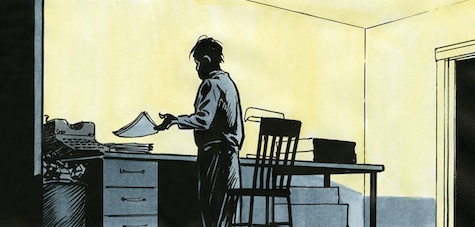
From the editors. While Alan Turing of course died long before TeX existed, there are several reasons why we think his biography as a graphic novel might be interesting for TUGboat readers. First, many of us are involved with computer science, and Turing was one of the founding fathers of this fascinating field. Second, both DEK and (more recently) Leslie Lamport are recipients of the Turing Award—the highest distinction for computer scientists. Third, many TUGboat readers are interested in modern book design, and therefore might appreciate an online graphic novel. Last but not least, this is an interesting and unusual book.
Alan Turing was a young man in search of himself as well as universal truths, or so he is cast by Ottaviani and Purvis in The Imitation Game. Socially awkward and eccentric, he nonetheless managed to gain success through a combination of innate genius and happenstance, the latter due to Great Britain’s involvement in World War II. The authors take us through Turing’s life from childhood, advanced mathematical and philosophical education, his lead role in breaking the German Enigma code, subsequent lack of recognition for theoretical accomplishments, and, finally, his persecution and premature death. The story is told by Turing, himself, his mother and a host of associates from various periods of his life. The dialog is, of course, conjectural reconstruction, but the authors do a convincing job of portraying the “essential” Turing and, for the most part, the narrative flows well.
The novel is decidedly not a primer on the Turing Machine or its underlying philosophical issues. It traverses critical points in the evolution of Turing’s thought processes in a manner assuming a fairly sophisticated knowledge on the part of the reader, knowledge this reviewer did not possess. The salutary effect (in my case and I suspect the same will be true for other readers) is to stimulate sufficient curiosity to research the critical issues. The Internet is replete with references to the entscheidungsproblem (Church–Turing thesis), working code for various iterations of Turing Machines and detailed analyses of the Enigma code and its decipherment (some heavy lifting involved but it fleshes out an understanding of the novel).
As noted earlier, Turing was not fully appreciated in his time beyond a small circle of colleagues. His brilliant, leading effort to break the Enigma code was largely masked due to national security issues. Then there was the familiar academic practice of extensive “borrowing” (some would say plagiarism) of ideas on the part of established, senior scholars (e.g. von Neumann) at the expense of lesser known contributors. But such slights paled in comparison to the tragic events of his final years. The authors walk us through Turing’s arrest and trial for homosexuality (a fact he did not challenge), the subsequent conviction and his untimely death (the authors accept the designation of suicide whereas others opt for accidental ingestion of cyanide). I believe that the authors have here missed an opportunity to place these events in broader context so as to clearly convey the ludicrous irony involved.
The issue involved the academic imprimatur afforded eugenics at the time. Led by Charles Davenport in the United States, positive (encouraging reproduction by superior lineages) and negative (elimination of inferior lineages) eugenics was a widely accepted, if terribly wrongheaded, derivation of Darwinian natural selection. Nazi Germany appropriated Davenport’s eugenics theory in toto and extended it to its logical ends: the enormity of genocide and the holocaust. Turing was awarded the OBE (Most Excellent Order of the British Empire) for his role in defeating Hitler and the Nazi regime. Yet he was convicted and chemically castrated for a crime, the rationale of which was based in the assumed validity of the theory of eugenics (i.e., the elimination of the “unfit” from the gene pool) and suffered the consequent physical impairment and ignominy. It should not be lost to history, or the readers of this novel, that Winston Churchill, who lauded Turing’s World War II contributions, was a vocal advocate of eugenics for the improvement of the British people.
In sum, with the above exception noted, I found the novel both illuminating for those unfamiliar with Turing’s too-brief life history and stimulative of additional research for those interested in the more arcane aspects addressed. A good read.